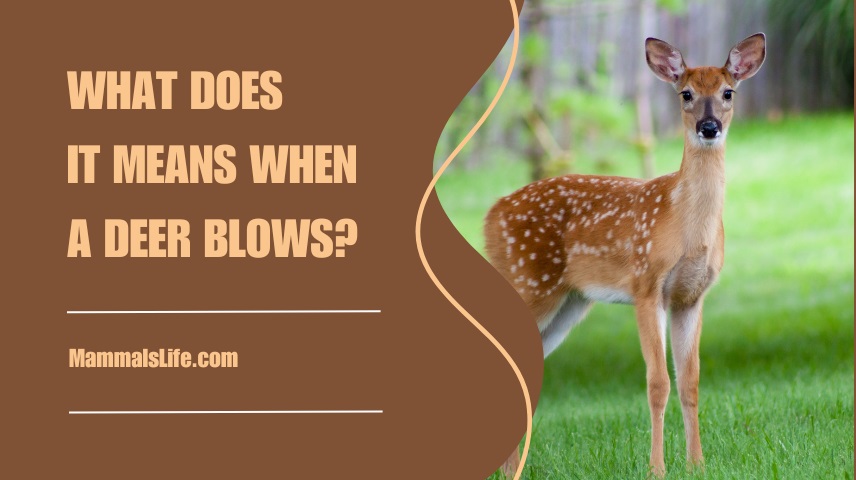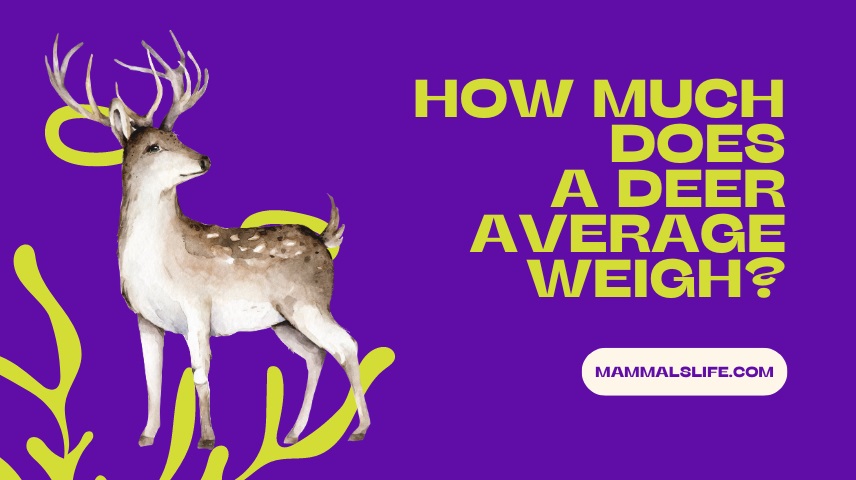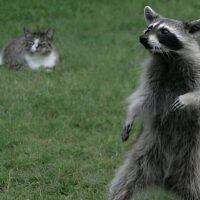Last Updated on February 22, 2025 by Mammals Life
When a deer blows, it snorts loudly to alert other deer of potential danger. This sound is a warning signal.
Deer blowing is a common behavior observed in wild deer populations. This loud snort serves as an alarm to other deer in the vicinity. Hunters and wildlife enthusiasts often hear this sound in forests and fields. Understanding why deer blow can help in interpreting their behavior.
This reaction typically indicates that a deer has sensed danger, often from predators or humans. By blowing, the deer communicates a warning to its group, enhancing their chances of survival. Recognizing and interpreting this behavior can provide valuable insights into deer habits and movements.
Deer Behavior Basics
Understanding deer behavior is essential for nature enthusiasts. Deer are fascinating animals with unique ways of communicating. One common reaction is when a deer blows. This sound can mean different things and is crucial for their survival.
Common Deer Reactions
Deer have various reactions to their surroundings. Here are some common behaviors:
- Blowing: A loud, snorting sound to signal danger.
- Stomping: When a deer stamps its foot to warn others.
- Fleeing: Running away quickly when threatened.
Communication Methods
Deer communicate in several ways. They use sounds, body language, and scents. Here are some methods:
- Sounds: Blowing, grunting, and bleating.
- Body Language: Ear movements, tail flicks, and body postures.
- Scents: Using glandular secretions to mark territory.
| Method | Description |
|---|---|
| Blowing | A warning sound to alert other deer. |
| Grunting | Used by males during the mating season. |
| Bleating | A sound made by fawns to call their mothers. |
Understanding these behaviors helps us appreciate deer more. It also aids in wildlife conservation efforts. Knowing what a deer blow means can enhance our outdoor experiences.
The Meaning Of Blowing
When a deer blows, it can be quite startling. This blowing sound is a strong, audible exhale. The deer uses this sound for specific reasons. Understanding these reasons can help you better interpret deer behavior.
Sound Characteristics
Deer blowing sounds like a loud, sharp snort. It can be heard from quite a distance. This sound is different from other deer noises. It is unique and easily recognizable.
Blowing usually happens in rapid bursts. Sometimes, it is a single blow, followed by silence. Each blow is an alert to other deer. It signals a potential threat in the area.
Situational Context
Deer blows primarily when they feel threatened. They may sense a predator or an unfamiliar human. This sound warns other deer in the vicinity.
Blowing can also occur during social interactions. Sometimes, deer blow during disputes or dominance displays. This is a way to assert control.
Understanding the situational context of blowing can help in wildlife observation. It provides insights into deer behavior and environment.
| Situation | Reason for Blowing |
|---|---|
| Threat Detection | Warns other deer of danger |
| Social Interaction | Displays dominance or disputes |
Alarm And Warning Signals
Deer uses a unique sound to warn others of danger. This sound is known as blowing. The blowing sound is an important alarm and warning signal. Understanding this behavior can help us learn more about deer communication.
Predator Detection
When a deer senses a predator, it blows to alert others. This sharp sound travels quickly through the forest. Deer have keen senses and can detect predators from far away. Blowing helps them stay safe and avoid danger.
- Deer use their sense of smell to detect predators.
- They also rely on their sharp vision and hearing.
- The blowing sound is a quick and effective warning.
Herd Alert Systems
Blowing is part of the deer’s herd alert system. When one deer blows, others become alert and ready to flee. This helps the entire herd stay safe. Deer often live in groups, so communication is key.
- One deer detects danger and blows.
- Other deer hear the blow and become alert.
- The herd prepares to run away if needed.
Understanding these signals can help us observe deer without disturbing them. Next time you hear a deer blow, you’ll know it’s a vital warning signal.
Environmental Triggers
Deer are sensitive creatures. They react quickly to changes in their environment. One common reaction is blowing. This sound alerts other deer to danger. Understanding the triggers helps us understand their behavior.
Human Presence
Deer can sense humans from a distance. They use their keen sense of smell and hearing. When they detect a human, they often blow. This is a warning signal. It tells other deer to be alert. The presence of humans can make deer feel threatened. They may run away after blowing. This is their way of staying safe.
Natural Disturbances
Deer also reacts to natural disturbances. These can include strong winds, storms, or other animals. Loud noises can startle them. When they hear something unusual, they blow. This alerts the herd to possible danger. Deer are always on the lookout for predators. Natural disturbances keep them on their toes. They need to stay vigilant to survive in the wild.
Impact On Deer Populations
The sound of a deer blowing can affect deer populations. Deer blowing is a warning signal to other deer. This sound can trigger various reactions within the herd.
Stress Responses
Deer blowing can cause stress in the herd. The sudden noise alerts deer to potential danger. This stress response can affect deer health over time.
Frequent stress can lead to various health issues. Deer may experience weight loss or weakened immune systems. This can make them more vulnerable to diseases.
Behavioral Adaptations
Deer blowing also leads to behavioral changes. Deer may become more alert and cautious. They might change their grazing patterns to stay safe.
These behavioral adaptations help deer avoid predators. Deer may also adjust their habitat use. They might avoid areas where they frequently blow.
| Impact | Description |
|---|---|
| Stress Responses | Health issues like weight loss and weakened immunity. |
| Behavioral Adaptations | Increased caution, altered grazing patterns, and habitat use. |
Understanding the impact of deer blowing helps in wildlife management. It is crucial for maintaining healthy deer populations.
Observing Deer In The Wild
Observing deer in their natural habitat is an exciting experience. It’s a chance to see these graceful creatures up close. But it’s important to understand their behaviors, especially when they blow.
Deer blowing is a common reaction and understanding it can enrich your wildlife-watching experience. This behavior often indicates that the deer has sensed danger.
Safety Precautions
When you’re out in the wild, safety should be your top priority. Follow these safety precautions to ensure a safe and enjoyable experience:
- Wear bright colors: This makes you visible to other people.
- Keep a safe distance: Don’t get too close to the deer.
- Stay quiet: Sudden noises can startle the deer and cause them to flee.
- Know your surroundings: Be aware of the terrain and any potential hazards.
Ethical Wildlife Watching
Ethical wildlife watching is crucial for the well-being of deer and other animals. Here are some guidelines to follow:
- Respect their space: Keep a respectful distance from the deer.
- Do not feed them: Feeding wildlife can be harmful to their health.
- Leave no trace: Take all your litter with you to protect their habitat.
- Observe quietly: Loud noises can cause stress to the animals.
By following these guidelines, you can ensure a positive experience for both you and the deer.
Frequently Asked Questions
When A Deer Blows, Will It Come Back?
A deer may return after blowing if it feels safe. It depends on the deer’s comfort level and surroundings.
What Does It Mean When A Deer Snorts?
A deer snorts to signal danger or alert other deer. It can also mean the deer is startled or agitated.
Why Do Deer Huff And Stomp?
Deer huff and stomp to signal danger. These actions warn other deer and deter potential predators.
How Do Deer React To A Miss?
Deer often flees quickly after a miss. They may run a short distance and then stop to assess danger.
What Is A Deer Blow?
A deer blow is a loud, forceful exhale. It signals alarm or distress.
Why Do Deer Blow?
Deer blow to alert others of danger. This sound warns the herd.
Conclusion
Understanding why a deer blows enhances our appreciation of wildlife behavior. This reaction signals alertness and danger. By recognizing these signs, we can better coexist with deer. Stay informed and respectful of their instincts. Keep exploring nature’s wonders for a deeper connection with the animal kingdom.











